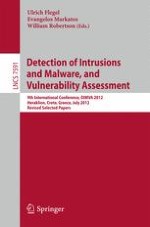2013 | Book
Detection of Intrusions and Malware, and Vulnerability Assessment
9th International Conference, DIMVA 2012, Heraklion, Crete, Greece, July 26-27, 2012, Revised Selected Papers
Editors: Ulrich Flegel, Evangelos Markatos, William Robertson
Publisher: Springer Berlin Heidelberg
Book Series : Lecture Notes in Computer Science
